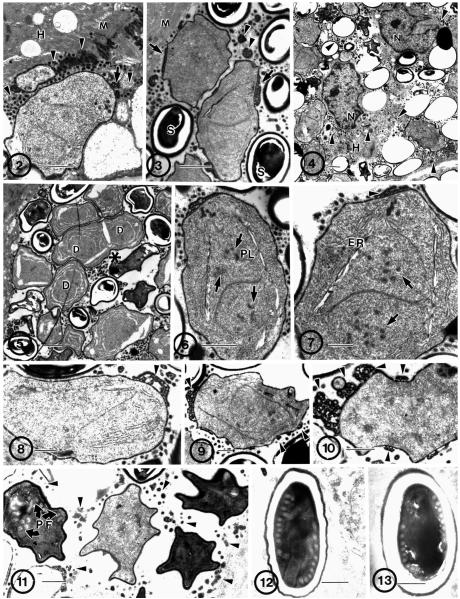Fig. 2–13.
Electron microscopic overview of infected human muscle biopsy tissue containing developmental stages of the microsporidial parasite, Brachiola algerae (Hba). 2. Early proliferative stages of the parasite in direct contact with the host muscle-cell cytoplasm (H). Note the presence of vesiculotubular appendages (arrow) attached to the parasite thickened plasmalemma, forming many dense bodies (arrowhead) in the host cytoplasm surrounding the parasite cells and abutting the host myofilaments (M). Bar = 1 μm. 3. Diplokaryotic proliferative parasite cells and spores (S). Note the attachment of the vesiculotubular appendages (arrows) to the proliferative cells but not to the spores. Dense appendage material is present in the space between parasite cells (arrowheads). Bar = 1 μm. 4. Low-power electron micrograph of clustered parasites in host cell cytoplasm (H). Host nuclei (N) and cytoplasm in direct contact with parasite cells and dense vesiculotubular appendage material (arrowheads) scattered throughout host cytoplasm. Note the lack of myofilaments between parasite cells. Bar = 1 μm. 5. All parasite stages are present and intermixed, an indication of asynchronous development. Cytokinesis and karyokinesis are linked, resulting in individual organisms containing one diplokaryon (D) or two with indications of cell division (*). Bar = 1 μm. 6. Proliferative cell containing a diplokaryon with condensed chromatin (arrows) and a spindle plaque (PL), indicating karyokinetic activity. Bar = 1 μm. 7. Proliferative cell containing a diplokaryon with condensed chromatin (arrows), extensive ER, and attached dense vesiculotubular appendages (arrowhead). Bar = 0.5 μm. 8–10. Sporonts. Note the change in appearance of the appendages (arrowhead) to clumps of dense material detaching from the plasmalemma. 8. Early sporont. Note the relatively lower cytoplasmic density when compared to the other two. Bar = 0.5 μm. 9. Note the presence of condensing chromatin in the sporont nucleus; it indicates the disporous nature of this parasite. Bar = 0.5 μm. 10. Note the abundance of dense vesiculotubular appendage material (arrowhead) in the process of being sloughed off the plasmalemma as it becomes more homogeneously dense. Bar = 0.5 μm. 11. Four sporoblasts with homogeneously thickened plasmalemma (after last cell division) and lacking attached appendages visible in the surrounding cytoplasm (arrowheads). Note the presence of the forming polar filament (PF). Bar = 0.5 μm. 12–13. Typical spores of B. algerae with 9–11 polar filament coils. 12. Early activated spore. Note the translocation of some polar filament coils. Bar = 0.5 μm. 13. Mature resting spore. Bar = 0.5 μm.

